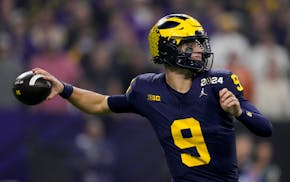Over the next few seasons, the Twins' best young players will begin appearing on the covers of magazines and media guides, perhaps even playoff game programs, but the smiles of Byron Buxton and Miguel Sano may never be as emblematic of the franchise's progress as the grimace of Ricky Nolasco.
The Twins planned to enter the season with Nolasco as a long reliever and spot starter. He beat the odds by beating out Tyler Duffey, one of the Twins' more effective pitchers down the stretch last year, for the fifth starter's job in the rotation.
That Nolasco's role is so minuscule tells you more about the team's stability than the improbable arc of a Sano home run.
Terry Ryan returned as Twins general manager before the 2012 season. Ryan's successes in that position in the 2000s were born of patience, organizational stability and pitching depth.
After the first two years of his second stint on the job, he assessed the pitching throughout his organization and realized he needed help. He discarded two of his beliefs — that winning organizations develop their own pitching, and that spending big money in free agency is often counterproductive — and signed Nolasco to a four-year contract worth $49 million.
Even at that relatively low price on the free-agent market, Nolasco has been a disaster. His signing offers lessons and reminders.
When the Twins signed Nolasco, he became their de facto ace. The Twins' big-league pitching was so hopeless that Nolasco, who always had been an average to above-average starter in the National League, would be asked to lead.
Nolasco has compiled ERAs of 5.38 and 6.75 for the Twins. They are hoping he can do what they signed him to do — deliver about 200 decent innings a season — but now are asking him to do it from the other end of the rotation.
They may even be hoping that he pitches well enough for a short stretch that they can trade him, get rid of his salary, and then promote either Duffey or top pitching prospect Jose Berrios.
This is why Nolasco is emblematic of the Twins' improvement: They no longer need much from him.
He ''won" the fifth starter's job with a mediocre spring, but that might not qualify as a true victory.
In April, between built-in off days and expected rainouts, big-league teams know they might not use their fifth starter much.
In truth, Nolasco might be the Twins' eighth choice to start a big-league game at the moment, behind the four other starters in the rotation, Berrios, Duffey and reliever Trevor May. If the Twins farm system does its job, Nolasco may soon may fall out of the top 10.
Ryan allowed the state of the team's pitching to coax him into what turned out to be a terrible decision, signing a player for about $50 million who would have been a failure even had the decimal point moved two spaces to the left. Ryan accidentally proved his own point, that relying on free agency to build a staff is like relying on the lottery to provide retirement funds.
Ryan has signed three prominent free-agent pitchers in the past two years: Nolasco, Phil Hughes and Ervin Santana. In each case he could not have predicted the results.
Nolasco was far worse than his fairly consistent career numbers would have suggested.
Hughes was far better than expected in his first year. When the Twins signed him to a contract extension, he let them down last year.
Santana's reputation was as a likable, consistent professional. He may have been the one player who kept them from the playoffs last year. Instead of leading the staff, he was suspended for half the season for using performance-enhancing drugs and then was inconsistent.
Santana, Hughes and Nolasco all owe the Twins a good season. The difference among the three is that Nolasco owes them two.
Jim Souhan's podcast can be heard at MalePatternPodcasts.com. On Twitter: @SouhanStrib. • jsouhan@startribune.com

Souhan: Wolves fans made Game 1 special. Now bring on Game 2.

Souhan: Should Vikings even consider McCarthy in NFL draft?

Souhan: NAW erases Suns' lead, Game 1 advantage with big performance

Souhan: This is KAT's chance to prove Flip Saunders was right

